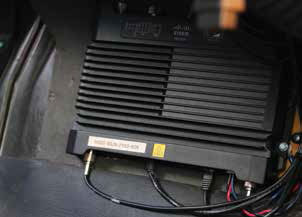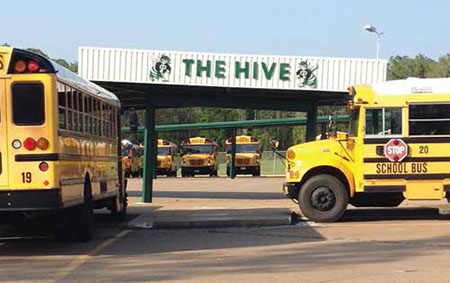MAGIC BUS : IN TEXAS, THEY DO EVERYTHING BIGGER, INCLUDING WIFI EXPANSION

Each smart bus is equipped with a Cisco 829 router. In the spring of 2013, Tim Hooks became transportation director at Huntsville (TX) Independent School District. Hooks, who had an administrative background, saw his job as going beyond simply managing the bus fleet. He spoke with everyone he could to learn about all the different jobs and responsibilities in his department, with the goal of discovering what they could do better.
Huntsville ISD covers 644 square miles. (Yes, you read that right.) Some students ride the bus for up to four hours a day. And just this past November, Hooks’ department received a request from a new family to pick up a student that will add 45 minutes to one of their bus routes. In addition, students go all over the state for competitions and sporting events.
Based on his initial conversations with people in his department, Hooks’ first idea was to put GPS on the buses. He met with Tracie Simental, the district’s executive director of technology, and from that meeting came a collaboration that has made Huntsville a trailblazer in the connected school bus movement.
DEVELOPING A WISH LIST
Hooks wanted to be able to locate his buses through GPS so he knew exactly where they were. He wanted real-time engine telematics for his mechanics so they could better diagnose buses remotely and make more accurate decisions, thus saving time and money. He wanted to be able to look at cameras in real time to see what’s going on, particularly in the case of a medical or security emergency. He wanted to know, through rider check-in and check-out, which students were getting on and off, and he wanted his drivers to hear turn-by-turn directions instead of having to read Yahoo Maps printouts in the dark. Hooks also wanted electronic pre-trip and post-trip reports so that, when a driver sees something, he or she can report it immediately so that a mechanic can order or fix a part to avoid any safety issues. Finally, he wanted parents to have an app to let them know when their children get on and off the bus, where the bus is located in relation to their stop, and when it will arrive. He wanted all of this information in one easy-to-use platform that dispatch could understand.

HOW TO CREATE A SMART BUS
Dispatchers see information from the Davra software on a large screen. On the left is the bus..Step 1: Talk it out. “Tracie and I wondered if we could do more than just GPS,” says Hooks. “We started talking about wifi, but figured that would be a long-term goal.” That fall, they both reached out to industry contacts to see what solutions were available that might suit their needs.
Tools and ideas to transform education. Sign up below.

Step 2: Develop a wish list. Huntsville’s list included all of the above-mentioned items, plus filtered wifi. Hooks’ advice? “Ask for everything you could want and then narrow it down to the must-haves.”
Step 3: Meet with vendors. When vendors came in, they met with both Hooks and Simental to discuss their wish list. No one had created a solution with everything on their wish list, so the district had to determine who they believed could deliver a fully developed product. “Every one of these features is available standard on any vehicle; why not on a bus that transports millions of kids every day?” asks Hooks.
Step 4: Choose the vendor with the best answers. Hooks says Presidio was the only company that said it could handle everything. “Other companies offered a solution and wanted us to fit it, but Presidio listened to what we wanted and made the solution fit us. They accepted it as a challenge.”
Step 5: Build, revise, repeat. Huntsville and Presidio spent a year and a half developing, tweaking, and modifying the solution. “One of the other good things about Presidio is that its solution doesn’t tie to any one vendor,” says Hooks. “They don’t care what camera I use, who my cell phone provider is, or the bus make and model. They integrate it all together.”
Step 6: Pilots, pilots, pilots. Huntsville is currently piloting the solution on 15 buses. As is always the case with a new implementation, they are finding and fixing things as they train 15 drivers, 15 groups of students, and 15 groups of parents. “We are getting feedback and having daily conference calls with Presidio, updating them, asking questions, and discussing the various pieces and tweaks that are still needed.”
THE NEAR FUTURE
Right now, Huntsville ISD is the only district Hooks knows about that has a full solution on a bus. As part of its 1:1 program, students in grades 7 through 12 have take-home Chromebooks, and sixth graders will be joining their ranks soon. Thanks to the bus wifi, students will get an extra two to four hours a day to finish homework or extend their learning.
When the solution is perfected, Hooks plans to add it to all 87 buses as well as to 40 additional vehicles that transport students.
“The way I see it, something like this should be standard on every bus,” he says. “Our parents and coaches love it because students are getting home from a game at 11 p.m. and are finished with their homework.”
TOOLS THEY USE
► Aphelia Collaboration System by Technuf
► Android tablets
► AngelTrax
► Cisco
► Davra
► Intel
► Presidio
